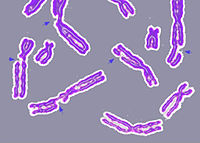
Photo from wikipedia
Simple Summary Induction chemotherapy (IC) plus concurrent chemoradiotherapy has been recommended as the standard treatment for locoregionally advanced nasopharyngeal carcinoma (LA-NPC). However, concurrent chemotherapy was associated with increased toxicities, poor… Click to show full abstract
Simple Summary Induction chemotherapy (IC) plus concurrent chemoradiotherapy has been recommended as the standard treatment for locoregionally advanced nasopharyngeal carcinoma (LA-NPC). However, concurrent chemotherapy was associated with increased toxicities, poor tolerance, and low completion rates. The aim of this study was to compare the efficacy and toxicity of IC + radiotherapy (RT) and IC + concurrent or adjuvant chemoradiotherapy (IC + CCRT/AC) in patients with negative post-IC EBV DNA. The results showed that IC + RT alone displayed similar efficacy to IC + CCRT/AC. The omission of concurrent or adjuvant chemotherapy did not increase locoregional or distant failure. However, patients treated with IC + RT had fewer acute toxicities than those with IC + CCRT/AC. Our finding provided evidence that the omission of concurrent or adjuvant chemotherapy may be feasible for patients with negative EBV DNA after induction chemotherapy. Abstract The purpose of this study was to compare the efficacy and toxicity of induction chemotherapy (IC) plus radiotherapy (RT) and IC plus concurrent or adjuvant chemoradiotherapy (CCRT/AC) in nasopharyngeal carcinoma (NPC) patients with negative Epstein–Barr virus DNA (EBV DNA) after IC. A total of 547 NPC patients with negative plasma EBV DNA post-IC were included. Patients were classified into the IC + RT group and the IC + CCRT/AC group. Locoregional relapse-free survival (LRFS), distant metastasis-free survival (DMFS), overall survival (OS), and progression-free survival (PFS) were estimated and compared using the Kaplan–Meier method. Propensity score matching (PSM) was performed to balance the variables. The median follow-up time was 37 months. The 3-year LRFS, DMFS, OS, and PFS rates for the whole group were 92.2%, 92.4%, 96.4%, and 84.4%, respectively. There was no significant difference in LRFS, DMFS, OS, and PFS between the IC + RT and the IC + CCRT/AC groups, both before PSM (3-year rates of 91.1% vs. 92.6%, p = 0.94; 95.6% vs. 91.5%, p = 0.08; 95.2% vs. 96.8%, p = 0.80; 85.9% vs. 84.0%, p = 0.38) and after PSM (90.7% vs. 92.7%, p = 0.77; 96.8% vs. 93.7%, p = 0.29; 94.5% vs. 93.9%, p = 0.57; 84.7% vs. 85.6%, p = 0.96). Multivariate analysis demonstrated that the treatment schedule was not an independent predictor for survival rates. Patients in the IC + RT group had fewer treatment-related acute toxicities and better tolerance. IC + RT displayed similar survival outcomes as IC + CCRT/AC for NPC patients with negative post-IC EBV DNA.
Journal Title: Cancers
Year Published: 2023
Link to full text (if available)
Share on Social Media: Sign Up to like & get
recommendations!